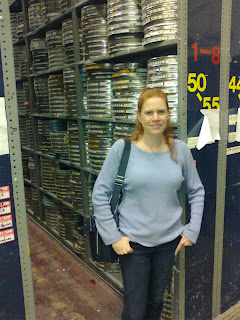After episode 427: (The Seeds of Doom, part six)
July 1976
<< back to 1975
You can establish the credentials of a Doctor Who fan with a few quick questions. Who is their favourite Doctor? What was the first story they ever saw - and do they know the name of it and when it was broadcast? What episode was first broadcast closest to the day they were born - and do they have to work it out or do they already know?
I was born in June 1976 in the gap between the end of Season 13 (The Seeds of Doom, part six, was first broadcast on 6 March) and the start of Season 14 (The Masque of Mandragora, part one, was first broadcast on 4 September). So I like to think that my birth story is the LP Doctor Who and the Pescatons, released that July.
It was the first Doctor Who story produced in the audio format, and starred the two leads of the show at the time (Tom Baker and Elisabeth Sladen recorded an episode of the educational radio programme Exploration Earth a few weeks before they recorded The Pescatons, but that episode - "The Time Machine" wasn't broadcast until October).
It's a daft old story - a giant space fish invades London before the Doctor and Sarah Jane can defeat it using special sound. Writer Victor Pemberton reused elements (i.e. the whole plot) of his Second Doctor story Fury from the Deep (1968) - which had itself reused elements of an earlier radio play.
Listening to it again, I realised how similar the format is to a lot of the Doctor Who audio adventures I write now for Big Finish. It's two episodes; it's a mixture of narration and dramatised scenes; there's one guest actor; and it tells an ambitious story that the TV show probably couldn't afford to realise while still trying to emulate the feel of the TV show of the time.
But for all it stars Tom Baker and Elisabeth Sladen as the Doctor and Sarah Jane, their characters don't quite ring true. The tone is really peculiar. The Doctor's narration is oddly jokey delivery, such as in this scene from episode 2:
I don't mean this as any kind of judgement on The Pescatons, just to note the historic moment and show how things have changed. After all, how can you not love a story in which the Doctor saves Sarah Jane and a baby from a giant alien fish by singing "Hello Dolly!"?
Next episode: 1977
July 1976
<< back to 1975
 |
| Doctor Who and the Fish Invasion of London |
I was born in June 1976 in the gap between the end of Season 13 (The Seeds of Doom, part six, was first broadcast on 6 March) and the start of Season 14 (The Masque of Mandragora, part one, was first broadcast on 4 September). So I like to think that my birth story is the LP Doctor Who and the Pescatons, released that July.
It was the first Doctor Who story produced in the audio format, and starred the two leads of the show at the time (Tom Baker and Elisabeth Sladen recorded an episode of the educational radio programme Exploration Earth a few weeks before they recorded The Pescatons, but that episode - "The Time Machine" wasn't broadcast until October).
It's a daft old story - a giant space fish invades London before the Doctor and Sarah Jane can defeat it using special sound. Writer Victor Pemberton reused elements (i.e. the whole plot) of his Second Doctor story Fury from the Deep (1968) - which had itself reused elements of an earlier radio play.
Listening to it again, I realised how similar the format is to a lot of the Doctor Who audio adventures I write now for Big Finish. It's two episodes; it's a mixture of narration and dramatised scenes; there's one guest actor; and it tells an ambitious story that the TV show probably couldn't afford to realise while still trying to emulate the feel of the TV show of the time.
The Pescatons has clearly been written with Tom Baker's Doctor in mind - it's full of his eccentricity and strangeness, and the action scenes are more violent than anything from the Second Doctor's time.
But for all it stars Tom Baker and Elisabeth Sladen as the Doctor and Sarah Jane, their characters don't quite ring true. The tone is really peculiar. The Doctor's narration is oddly jokey delivery, such as in this scene from episode 2:
The creature reared up; its long, pointed teeth moving in for the attack. For one moment, it looked as though the creature was going to ignore me and claw straight into Sarah Jane and the baby. To regain its attention, I had to do just about everything except turn a cartwheel. Thinking about it, I'm not too sure I didn't even do that. Anything I could lay my hands on I threw at it: stones, dustpan bins, milk bottles, even an old boot somebody had discarded in rather a hurry. But still the creature ignored me and slid closer and closer towards Sarah Jane and the baby.It might have his voice but this doesn't sound like the Doctor. Today, that sort of thing would usually be picked up and corrected by the script editor and producer, or caught by the unblinking eye that we refer to, in hushed whisper, as "Cardiff". I suspect the Doctor making jokes while a baby was in danger would also be cause for concern.
I don't mean this as any kind of judgement on The Pescatons, just to note the historic moment and show how things have changed. After all, how can you not love a story in which the Doctor saves Sarah Jane and a baby from a giant alien fish by singing "Hello Dolly!"?
Next episode: 1977







































